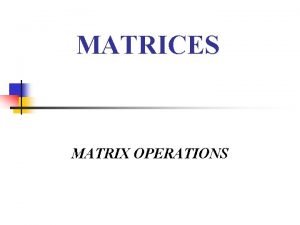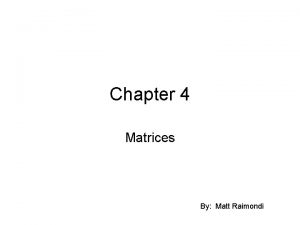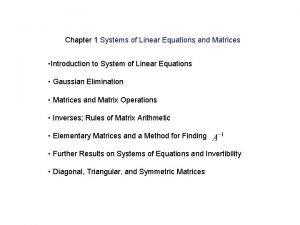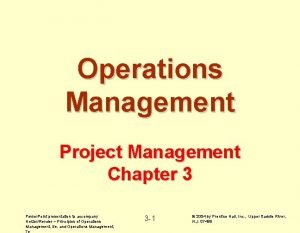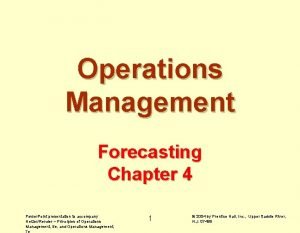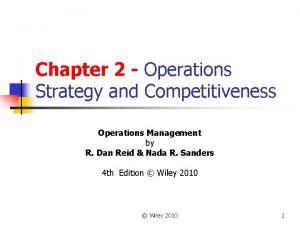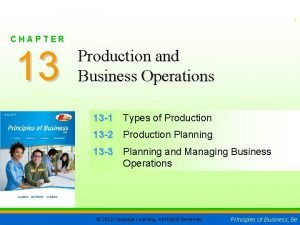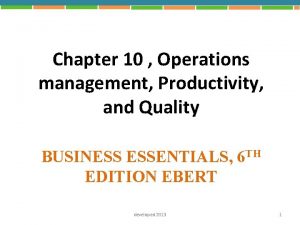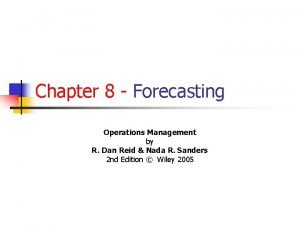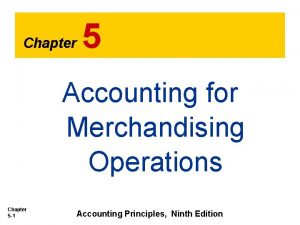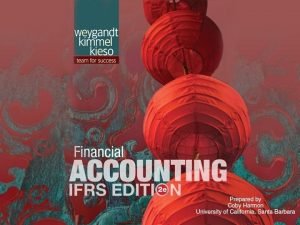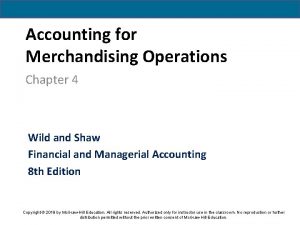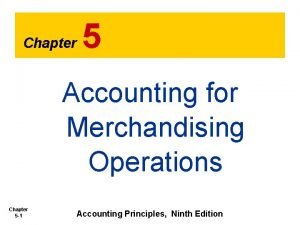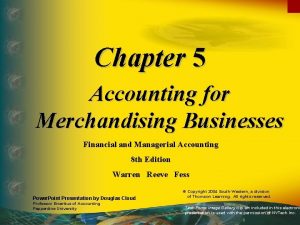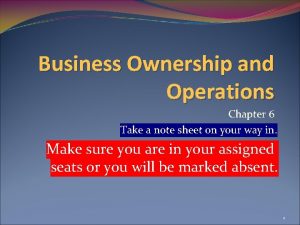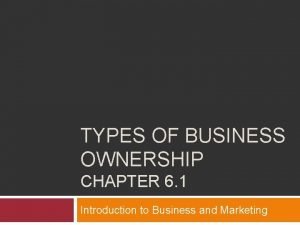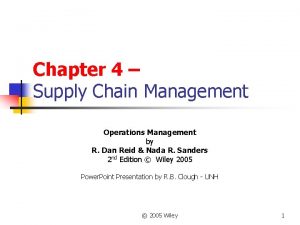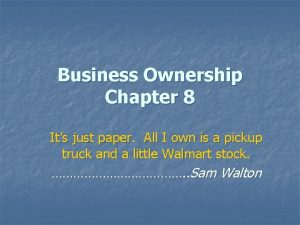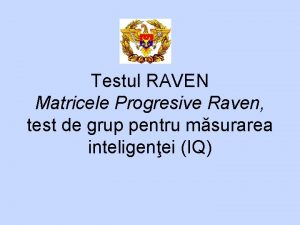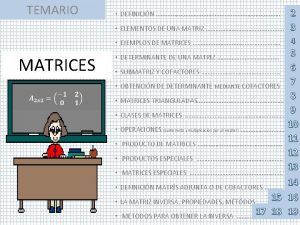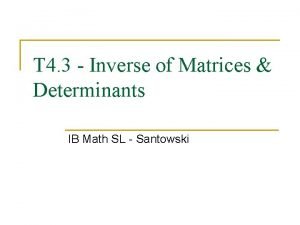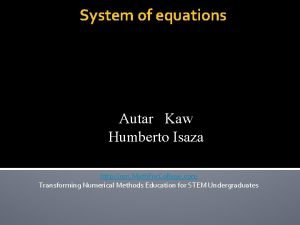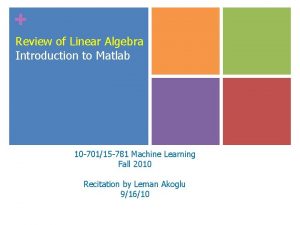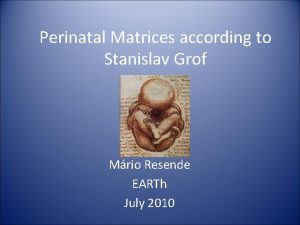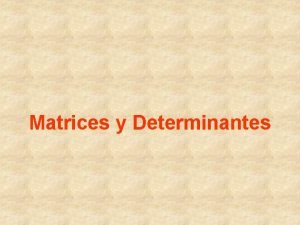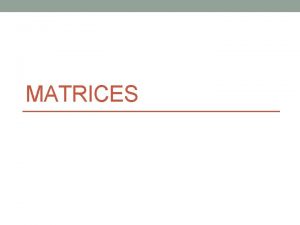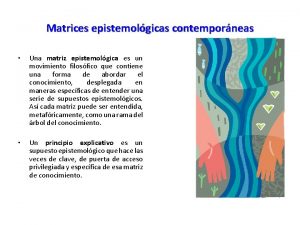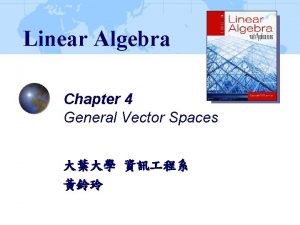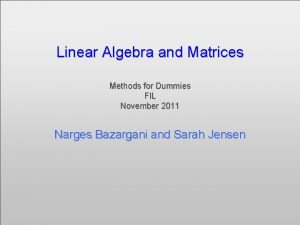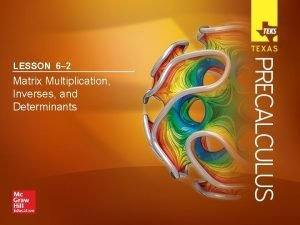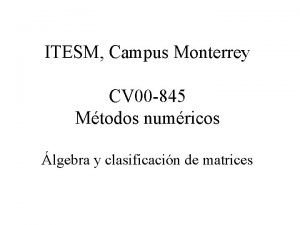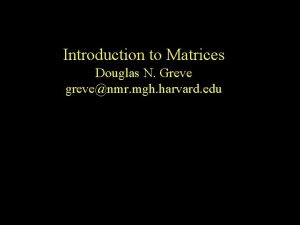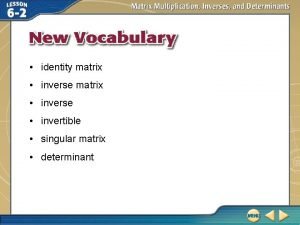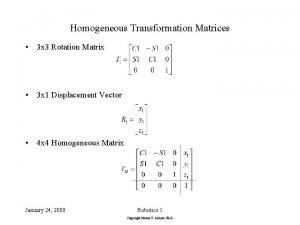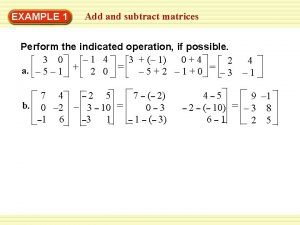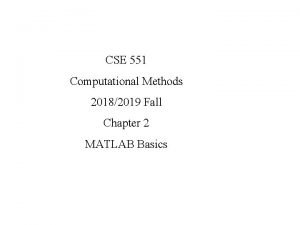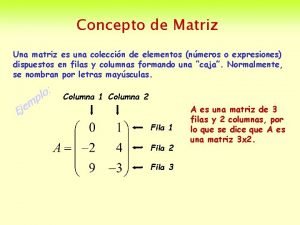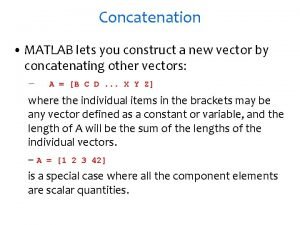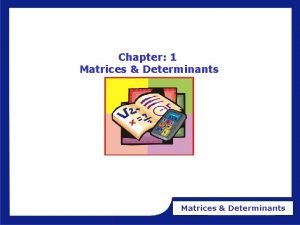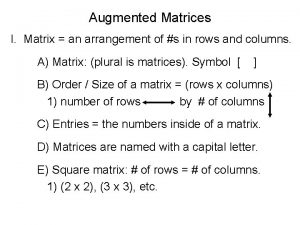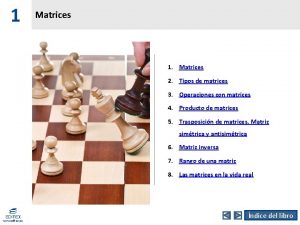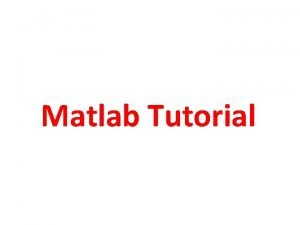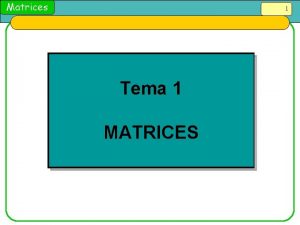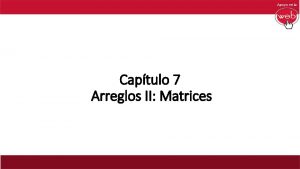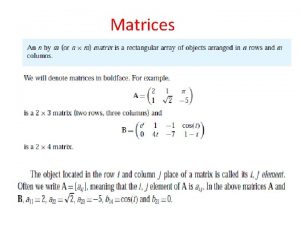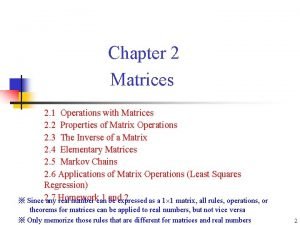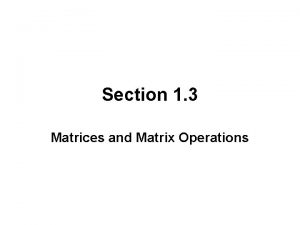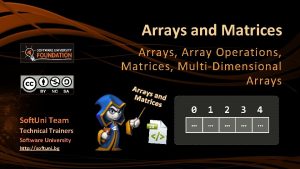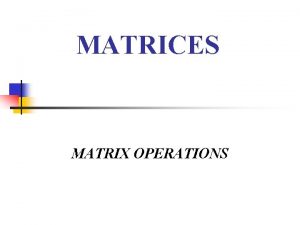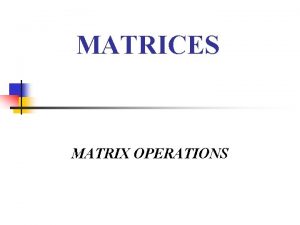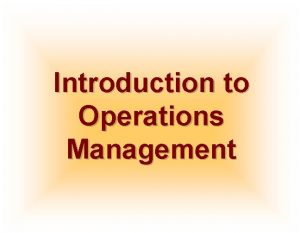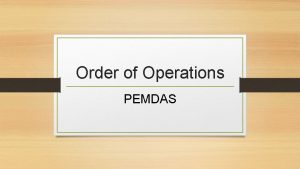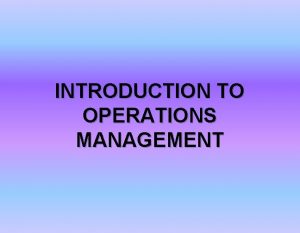Chapter 2 Matrices 2 1 Operations with Matrices





























































- Slides: 61

Chapter 2 Matrices 2. 1 Operations with Matrices 2. 2 Properties of Matrix Operations 2. 3 The Inverse of a Matrix 2. 4 Elementary Matrices

2. 1 Operations with Matrices n Matrix: (i, j)-th entry: row: m column: n size: m×n 2/61

n i-th row vector row matrix n j-th column vector column matrix n Square matrix: m=n 3/61

n Diagonal matrix: n Trace: 4/61

n Ex: 5/61

n Equal matrix: n Ex 1: (Equal matrix) 6/61

n n Matrix addition: Ex 2: (Matrix addition) 7/61

n Scalar multiplication: n Matrix subtraction: n Ex 3: (Scalar multiplication and matrix subtraction) Find (a) 3 A, (b) –B, (c) 3 A – B 8/61

Sol: (a) (b) (c) 9/61

n Matrix multiplication: Size of AB where n Notes: (1) A+B = B+A, (2) 10/61

n Ex 4: (Find AB) Sol: 11/61

n Matrix form of a system of linear equations: x = = = A b 12/61

n Partitioned matrices: submatrix 13/61

Keywords in Section 2. 1: n row vector: ﻣﺘﺠﻪ ﺻﻔﻲ n column vector: ( )ﻣﺘﺠﻪ ﻋﻤﻮﺩﻱ Might imply orthogonal vector! n diagonal matrix: ﻣﺼﻔﻮﻓﺔ ﻗﻄﺮﻳﺔ n trace: ﺍﺛﺮ n equality of matrices: ﺗﻌﺎﺩﻝ ﺍﻟﻤﺼﻔﻮﻓﺎﺕ n matrix addition: ﺟﻤﻊ ﺍﻟﻤﺼﻔﻮﻓﺎﺕ n scalar multiplication: ﺿﺮﺏ ﺑﻌﺪﺩ ﺛﺎﺑﺖ n matrix multiplication: ﺿﺮﺏ ﺍﻟﻤﺼﻔﻮﻓﺎﺕ n partitioned matrix: ﻣﺼﻔﻮﻓﺔ ﻣﺠﺰﺋﺔ 14/61

2. 2 Properties of Matrix Operations n Three basic matrix operators: (1) matrix addition (2) scalar multiplication (3) matrix multiplication n Zero matrix: n Identity matrix of order n: 15/61

n Properties of matrix addition and scalar multiplication: Then (1) A+B = B + A (2) A + ( B + C ) = ( A + B ) + C (3) ( cd ) A = c ( d. A ) (4) 1 A = A (5) c( A+B ) = c. A + c. B (6) ( c+d ) A = c. A + d. A 16/61

n Properties of zero matrices: n Notes: (1) 0 m×n: the additive identity for the set of all m×n matrices (2) –A: the additive inverse of A 17/61

n Transpose of a matrix: 18/61

n Ex 8: (Find the transpose of the following matrix) (a) (b) (c ) Sol: (a) (b) (c ) 19/61

n Properties of transposes: 20/61

n Symmetric matrix: A square matrix A is symmetric if A = AT n Skew-symmetric matrix: A square matrix A is skew-symmetric if AT = –A n Ex: is symmetric, find a, b, c? Sol: 21/61

n Ex: is a skew-symmetric, find a, b, c? Sol: n Note: is symmetric Pf: 22/61

n n Real number: ab = ba (Commutative law for multiplication) Matrix: Three situations: (Sizes are not the same) (Sizes are the same, but matrices are not equal) 23/61

n Ex 4: Sow that AB and BA are not equal for the matrices. and Sol: n Note: 24/61

n Real number: (Cancellation law) n Matrix: (1) If C is invertible, then A = B (Cancellation is not valid) 25/61

n Ex 5: (An example in which cancellation is not valid) Show that AC=BC Sol: So But 26/61


2. 3 The Inverse of a Matrix n Inverse matrix: Consider Then (1) A is invertible (or nonsingular) (2) B is the inverse of A n Note: A matrix that does not have an inverse is called noninvertible (or singular). 28/61

n Thm 2. 7: (The inverse of a matrix is unique) If B and C are both inverses of the matrix A, then B = C. Pf: Consequently, the inverse of a matrix is unique. Note s: (1) The inverse of A is denoted by n 29/61

Find the inverse of a matrix by Gauss-Jordan Elimination: n n Ex 2: (Find the inverse of the matrix) Sol: 30/61

Thus 31/61

n Note: If A can’t be row reduced to I, then A is singular. 32/61

n Ex 3: (Find the inverse of the following matrix) Sol: 33/61

So the matrix A is invertible, and its inverse is n Check: 34/61

n Power of a square matrix: 35/61

n Thm 2. 8: (Properties of inverse matrices) If A is an invertible matrix, k is a positive integer, and c is a scalar not equal to zero, then 36/61

n Thm 2. 9: (The inverse of a product) If A and B are invertible matrices of size n, then AB is invertible and Pf: n Note: 37/61

n Thm 2. 10 (Cancellation properties) If C is an invertible matrix, then the following properties hold: (1) If AC=BC, then A=B (Right cancellation property) (2) If CA=CB, then A=B (Left cancellation property) Pf: n e: Not If C is not invertible, then cancellation is not valid. 38/61

n Thm 2. 11: (Systems of equations with unique solutions) If A is an invertible matrix, then the system of linear equations Ax = b has a unique solution given by Pf: ( A is nonsingular) (Left cancellation property) This solution is unique. 39/61

n Note: For square systems (those having the same number of equations as variables), Theorem 2. 11 can be used to determine whether the system has a unique solution. n Note: (A is an invertible matrix) 40/61

Keywords in Section 2. 3: n inverse matrix: ﻣﺼﻔﻮﻓﺔ ﻋﻜﺴﻴﺔ n invertible: ﻗﺎﺑﻠﺔ ﻟﻠﻌﻜﺲ n nonsingular: ﻏﻴﺮ ﻣﻨﻔﺮﺩ n singular: ﻣﻨﻔﺮﺩ n power: ﻗﻮﺓ 41/61

2. 4 Elementary Matrices n Row elementary matrix: An n n matrix is called an elementary matrix if it can be obtained from the identity matrix In by a single elementary operation. n Three row elementary matrices: Interchange two rows. Multiply a row by a nonzero constant. Add a multiple of a row to another row. n Note: Only do a single elementary row operation. 42/61

n Ex 1: (Elementary matrices and nonelementary matrices) 43/61

n Thm 2. 12: (Representing elementary row operations) Let E be the elementary matrix obtained by performing an elementary row operation on Im. If that same elementary row operation is performed on an m n matrix A, then the resulting matrix is given by the product EA. n Notes: 44/61

Ex 2: (Elementary matrices and elementary row operation) n 45/61

n Ex 3: (Using elementary matrices) Find a sequence of elementary matrices that can be used to write the matrix A in row-echelon form. Sol: 46/61

row-echelon form 47/61

n Row-equivalent: Matrix B is row-equivalent to A if there exists a finite number of elementary matrices such that 48/61

n Thm 2. 13: (Elementary matrices are invertible) If E is an elementary matrix, then exists and is an elementary matrix. n Notes: 49/61

n Ex: Elementary Matrix Inverse Matrix (Elementary Matrix) 50/61

n Thm 2. 14: (A property of invertible matrices) A square matrix A is invertible if and only if it can be written as the product of elementary matrices. Pf: (1) Assume that A is the product of elementary matrices. (a) Every elementary matrix is invertible. (b) The product of invertible matrices is invertible. Thus A is invertible. (2) If A is invertible, has only the trivial solution. (Thm. 2. 11) Thus A can be written as the product of elementary matrices. 51/61

n Ex 4: Find a sequence of elementary matrices whose product is Sol: 52/61

n Note: If A is invertible 53/61

n Thm 2. 15: (Equivalent conditions) If A is an n n matrix, then the following statements are equivalent. (1) A is invertible. (2) Ax = b has a unique solution for every n 1 column matrix b. (3) Ax = 0 has only the trivial solution. (4) A is row-equivalent to In. (5) A can be written as the product of elementary matrices. 54/61

n LU-factorization: If the n n matrix A can be written as the product of a lower triangular matrix L and an upper triangular matrix U, then A=LU is an LU-factorization of A n L is a lower triangular matrix U is an upper triangular matrix Note: If a square matrix A can be row reduced to an upper triangular matrix U using only the row operation of adding a multiple of one row to another row below it, then it is easy to find an LUfactorization of A. 55/61

n Ex 5: (LU-factorization) Sol: (a) 56/61

(b) 57/61

n n Solving Ax=b with an LU-factorization of A Two steps: (1) Write y = Ux and solve Ly = b for y (2) Solve Ux = y for x 58/61

n Ex 7: (Solving a linear system using LU-factorization) Sol: 59/61

So Thus, the solution is 60/61

Keywords in Section 2. 4: n row elementary matrix: ﻣﺼﻔﻮﻓﺔ ﺻﻔﻴﺔ ﺃﻮﻟﻴﺔ n row equivalent: ﺗﻜﺎﻓﺆ ﺻﻔﻲ n lower triangular matrix: ﻣﺼﻔﻮﻓﺔ ﻣﺜﻠﺜﻴﺔ ﺳﻔﻠﻰ n upper triangular matrix: ﻣﺼﻔﻮﻓﺔ ﻣﺜﻠﺜﻴﺔ ﻋﻠﻴﺎ n LU-factorization: LU – ﺗﺤﻠﻴﻞ 61/61
 Operations with matrices
Operations with matrices Chapter 4 matrices answers
Chapter 4 matrices answers Homogeneous system of linear equations examples
Homogeneous system of linear equations examples Operations management chapter 3 ppt
Operations management chapter 3 ppt Operations management chapter 4 forecasting solutions
Operations management chapter 4 forecasting solutions Chapter 2 operations management
Chapter 2 operations management Role of operations management
Role of operations management Process selection in operations management
Process selection in operations management Chapter 2 operations strategy and competitiveness
Chapter 2 operations strategy and competitiveness Competitive operations strategy
Competitive operations strategy Chapter 13 study guide production and business operations
Chapter 13 study guide production and business operations Operations management chapter 10
Operations management chapter 10 Operations management chapter 10 quality control solutions
Operations management chapter 10 quality control solutions Chapter 8 operations management
Chapter 8 operations management Operations management chapter 3 forecasting solutions
Operations management chapter 3 forecasting solutions Merchandise in accounting
Merchandise in accounting Chapter 5 accounting for merchandising activities solutions
Chapter 5 accounting for merchandising activities solutions Understanding foodservice operations chapter 2
Understanding foodservice operations chapter 2 Operation and productivity chapter 1
Operation and productivity chapter 1 Crossover charts
Crossover charts Forecasting ppt in operations management
Forecasting ppt in operations management Chapter 12 inventory management
Chapter 12 inventory management Chapter 11 operations management
Chapter 11 operations management Human resource and job design in operations management
Human resource and job design in operations management Lodging operation
Lodging operation Chapter 4 accounting for merchandising operations
Chapter 4 accounting for merchandising operations Operations strategy in a global environment
Operations strategy in a global environment Chapter 5 accounting for merchandising operations
Chapter 5 accounting for merchandising operations Chapter 5 accounting for merchandising operations solutions
Chapter 5 accounting for merchandising operations solutions Chapter 6 business ownership and operations
Chapter 6 business ownership and operations Chapter 6 business ownership and operations
Chapter 6 business ownership and operations A business that moves goods from one business to another
A business that moves goods from one business to another Chapter 5 accounting for merchandising operations
Chapter 5 accounting for merchandising operations 4 flows of supply chain
4 flows of supply chain Chapter 6 business ownership and operations
Chapter 6 business ownership and operations Matrice progresive raven
Matrice progresive raven Cuando una matriz es idempotente
Cuando una matriz es idempotente Can matrices be divided
Can matrices be divided Can matrices be divided
Can matrices be divided Linear independence of vectors
Linear independence of vectors Woodcock johnson 4
Woodcock johnson 4 Stan grof coex
Stan grof coex Propiedades determinantes
Propiedades determinantes Igualdad de matrices
Igualdad de matrices Equations of matrices
Equations of matrices S shaped matrix
S shaped matrix Matrices
Matrices Matriz epistemologica
Matriz epistemologica Span in matrix algebra
Span in matrix algebra Matrices for dummies
Matrices for dummies 3 by 3 matrix
3 by 3 matrix Matrice fcb
Matrice fcb Clasificacion de matrices
Clasificacion de matrices Upper triangular matrix 3x4
Upper triangular matrix 3x4 Matrix singular
Matrix singular A homogeneous transformation matrix is in the order of
A homogeneous transformation matrix is in the order of Subtract matrices calculator
Subtract matrices calculator Division de matrices 3x3
Division de matrices 3x3 Fila y columna matriz
Fila y columna matriz Concatenation of vectors
Concatenation of vectors Area of triangle determinant
Area of triangle determinant Augmented matrices calculator
Augmented matrices calculator
